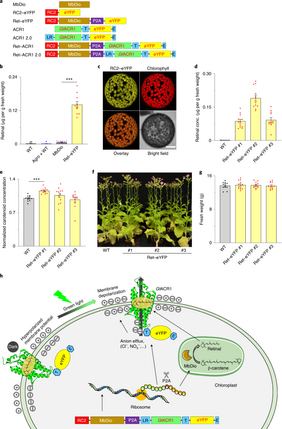Optogenetic control of plant growth by a microbial rhodopsin
07.02.2021Optogenetic control of plant growth by a microbial rhodopsin
Yang Zhou, Meiqi Ding, Shiqiang Gao, Jing Yu-Strzelczyk, Markus Krischke, Xiaodong Duan, Jana Leide, Markus Riederer, Martin J Mueller, Rainer Hedrich, Kai R Konrad, Georg Nagel
Nature Plants volume 7, pages 144–151 (2021)
While rhodopsin-based optogenetics has revolutionized neuroscience1,2, poor expression of opsins and the absence of the essential cofactor all-trans-retinal has complicated the application of rhodopsins in plants. Here, we demonstrate retinal production in plants and improved rhodopsin targeting for green light manipulation of plant cells using the Guillardia theta light-gated anion channelrhodopsin GtACR13. Green light induces a massive increase in anion permeability and pronounced membrane potential changes when GtACR1 is expressed, enabling non-invasive manipulation of plant growth and leaf development. Using light-driven anion loss, we could mimic drought conditions and bring about leaf wilting despite sufficient water supply. Expressed in pollen tubes, global GtACR1 activation triggers membrane potential depolarizations due to large anion currents. While global illumination was associated with a reversible growth arrest, local GtACR1 activation at the flanks of the apical dome steers growth direction away from the side with increased anion conductance. These results suggest a crucial role of anion permeability for the guidance of pollen tube tip growth. This plant optogenetic approach could be expanded to create an entire pallet of rhodopsin-based tools4, greatly facilitating dissection of plant ion-signalling pathways.


